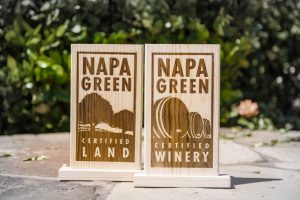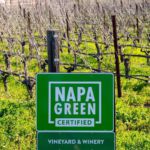Napa Green is described has a “soil to bottle” certification program focused on environmental and climate change issues with area wineries. A program of the 550-member Napa Valley Vintners trade group, it works with winery owners who agree to follow environmentally sensitive practices.
Recently announcing its Napa Green program had an 80% participation rate, the association also announced appointment of an executive director, Anna Brittain. She answered questions from the Business Journal.
First of all, where was the picture of you that picture of you taken?
Well, as you can probably tell I have some Irish heritage. The picture was taken in County Kerry on my first visit to Ireland with my mother in June 2019.
Owners who participate in the certification programs submit to third-party verification of good practices such as preventing erosion and sediment runoff to the betterment of creeks and the Napa River. Are participants more than just winery operators then?
Napa Green Certified Land and Napa Green Certified Winery are two complementary but distinct certifications, providing the opportunity for comprehensive soil to bottle certification, which sets Napa Green apart. The Napa Green Certified Land program supports growers and vineyard managers to develop comprehensive, whole farm conservation plans. This emphasis on the whole property and not just the vineyard also makes our land program distinct, encompassing roads and land along waterways for the health and resilience of the Napa River watershed.
The Napa Green Certified Winery program seeks to get owners and operators to agree reduce a winery’s environmental footprint, with third parties certifying that they have met certain standards. So is getting owners to sign up, what’s the biggest challenge?
The Napa Green Certified Winery program is both a practice- and performance-based program. Winery members commit to more than 100 sustainability practices to improve energy and water efficiency, prevent waste, take climate action and care for and engage employees.
The first challenge comes when winemakers and operations managers first look at the list of standards. I always emphasize that no one is starting from zero. Most wineries are already implementing 60%–70% of these best practices, so they just need to commit to keep moving up the ladder.
What is the biggest environmental challenge facing the wine industry in the Napa Valley today?
The biggest challenge facing us all is the climate crisis.
If you haven’t seen the Bill Nye “Safety Glasses” video, look it up. The wine industry alone can’t solve climate change, but … with arguably the premier agricultural product, our environmental leadership creates waves of impact in the beverage industry and beyond. Sustainability increases agricultural and business resilience.
This year Napa County is adopting a climate action plan, and Napa Green aims to grow our impact on climate action, including helping our members complete greenhouse gas inventories and helping growers adopt and implement “carbon farm plans” to sequester ever more carbon in the soil.




